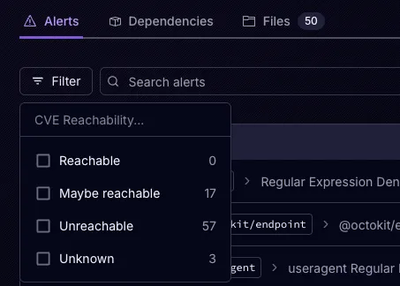
Product
Announcing Precomputed Reachability Analysis in Socket
Socket’s precomputed reachability slashes false positives by flagging up to 80% of vulnerabilities as irrelevant, with no setup and instant results.
.. image:: https://coveralls.io/repos/github/RedHatQE/navmazing/badge.svg?branch=master :target: https://coveralls.io/github/RedHatQE/navmazing?branch=master
Simple navigation framework supporting complex designs
navmazing is based around a number of navigation steps which subclass the NavigateStep object. These step objects have a relationship by defining a prerequisite method which can go to the previous step if it is determined that we are not current on the requested step. This chaining of steps starting at a first and visiting all the prerequisites in the chain until they are resolved constitutes a complete navigation.
An example is below. This creates a simple class modelling some Provider object that has three destinations or pages in the UI, a New page, a Details page and an All page. The New page is where a new Provider would be added, and the All page is where you could view a list of all of them. To get to the New page, you must first visit the All page. The Details page is where a specific provider would be displayed. In the example below you can see that we model some very simple steps and register them to the class.
.. code-block:: python
from navmazing import Navigate, NavigateStep, NavigateToSibling
navigator = Navigate()
class Provider(object): def init(self, name): self.name = name
@navigator.register(Provider, 'Details') class ProviderDetails(NavigateStep): prerequisite = NavigateToSibling('All')
def step(self):
click(self.obj.name)
@navigator.register(Provider, 'New') class AddANewProvider(NavigateStep): prerequisite = NavigateToSibling('All')
def step(self):
click('Add New Button')
@navigator.register(Provider, 'All') class ShowAllProviders(NavigateStep): def am_i_here(self): return check_if_i_am_already_on_page()
def step(self):
click('All button')
The class ShowAllProviders represents the step of getting to the All page. This class has two methods, am_i_here() and step(). The step() method describes how we should perform the step of getting to the All page. It is assumed in this particular UI that the All button is always visible. The am_i_here() method is a way to query to see if we are already on this page. This is used to shortcut navigation if it can be determined that we are already on a page that we have requested to visit.
The class AddANewProvider represents the step of getting to the New page. This class has an attribute and a method. The prerequisite is actually a python descriptor. It uses the NavigateToSibling helper to navigate to the All destination on the same object that it has been requested to visit the New page on. One could simply make prerequisite a function that calls navigate_to with self.obj and the All destination. However the helper is much nicer and makes defining prerequisite steps a little more cleaner.
The class ProviderDetails represents the step of getting to a specific providers page, its Details page. This class is the same as the AddANewProvider class in that it first requires the All button to be pressed. Notice in the step() method, that there is a reference to self.obj. This object is the object that is passed to navigation step as can be seen below. In the example below this object is called prov.
.. code-block:: python
def prerequisite(self): navigator.navigate(self.obj, 'All')
prerequisite = NavigateToSibling('All')
To use the code above, one would instantiate a Provider object and then use the navigate method like so:
.. code-block:: python
prov = Provider('name') navigator.navigate(prov, 'Details')
navmazing has a few helpers to make prerequisites easier to define
NavigateToSibling - Navigates to a destination that is registered to the same object as the current request.NavigateToAttribute - Navigates to a destination that is registered to an attribute of the same object as the current request. This is useful if there is some kind of hierarchy to your objects and you wish to navigate to a step that is registered against an attribute rather than the object itselfNavigateToObject - Navigates to a destination that is registered to the supplied object, it could be argued that NavigateToAttribute could be implemented with a NavigateToObject call, by simply offering the attribute object as the object. It feels more dynamic and cleaner to use NavigateToAttribute in these cases, there the attribute is a string that is looked up, rather than an object which is static.The diagram below shows the flowchart of the process of resolving a navigation using the stock navmazing library. As the methods are overridable, the flow can be altered, but should suffice for most usages.
.. image:: https://github.com/psav/navmazing/raw/master/flowchart.png
navmazing also allows parameters to be passed at the navigate call. This means you can allow for some level of dynamic nature or choice in your navigation destinations. Let's say for example you have a step that usually works one way, but there are certain times when you need to override that behaviour and make it work a different way.
.. code-block:: python
@navigator.register(Provider, 'Details') class ProviderDetails(NavigateStep) prerequisite = NavigateToSibling('All')
def step(self, active=True):
if choice:
click(self.obj.name)
else:
click(self.obj.name + " - inactive")
navigate(obj, 'Details')
navigate(obj, 'Details', active=False)
In the example above, passing the active parameter changes the behaviour of the step.
FAQs
Did you know?

Socket for GitHub automatically highlights issues in each pull request and monitors the health of all your open source dependencies. Discover the contents of your packages and block harmful activity before you install or update your dependencies.

Product
Socket’s precomputed reachability slashes false positives by flagging up to 80% of vulnerabilities as irrelevant, with no setup and instant results.

Product
Socket is launching experimental protection for Chrome extensions, scanning for malware and risky permissions to prevent silent supply chain attacks.

Product
Add secure dependency scanning to Claude Desktop with Socket MCP, a one-click extension that keeps your coding conversations safe from malicious packages.